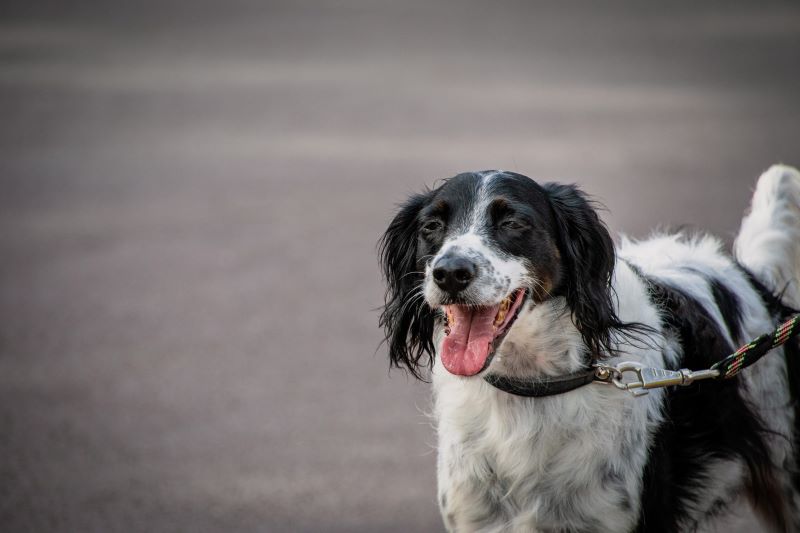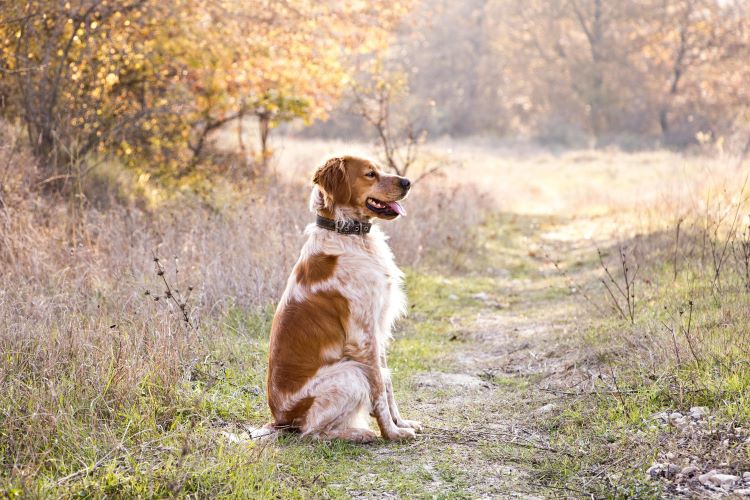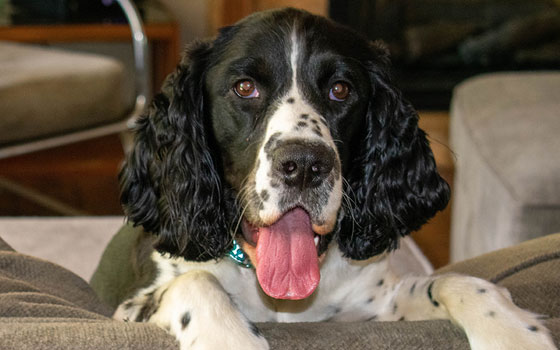Ready to help treat your pet to a healthy life?
Brittany Dog Breed: Fun Facts, History & Care Tips
By : Trupanion Staff | Updated May 27, 2024

American Brittany. French Brittany. Brittany Spaniel. The Brittany dog breed goes by a few different names and has a rich history with fans around the world. With their sweet and loving faces, these dogs are frequently found as devoted companions to individuals and families, especially in North America and Europe. But while they love affection, Brittanys are better known for being highly capable gun dogs, bred to hunt various types of fowl. They're also noted show champions, with a long history of titles in elite canine competition.
These are just some of the many interesting things that make Brittanys a special breed. Whether you're wondering whether a Brittany is the right dog for you or simply want to learn more about these marvelous pups, this breed guide has you covered.
7 fun facts about the Brittany dog breed
Wondering what makes the Brittany stand out? Here are some unique facts about these wonderful pups:
- The Brittany has earned more Dual Champion titles from the American Kennel Club (AKC) than all other sporting dog breeds combined. Since the 1940s, over 700 Brittanys have received the prestigious title.
- After World War II, Brittanys were hard to find in their native country of France, and breeders decided to allow dogs with greater color variation into their breeding programs to expand the gene pool.
- Brittanys come in a few different colors and coat textures. You might see a black and white Brittany, orange and white or liver and white, all with different degrees of spotting. Fur can be straight or wavy.
- Though docking was considered standard throughout the 20th Century, it has become less common in modern practice. Even so, some Brittanys are born with a naturally short tail.
- So, is it a spaniel? Until 1982, the breed’s official name was “Brittany Spaniel” in the United States, and it is still called “l'épagneul Breton” in France. However, the working style of the Brittany more closely resembles that of pointers in the field, rather than the flushing style of spaniels. Spaniels and pointer-type breeds are nevertheless classified in the same sporting dog category by the AKC.
- Brittanys were often used by poachers in the French countryside during the early 1800s, as they were small and quick partners in crime when hunting for fowl.
- The Brittany tends to live longer than the average dog breed, with an expected lifespan between 12 and 14 years.
Get to know the Brittany
The Brittany has short, spaniel-like ears and the long legs of a pointer. Brittanys take their enthusiasm to the next level — they are willing and able to tackle whatever activity you have in mind. One of the most energetic dog breeds, Brittanys are smart and like to work closely with their person. Versatile and eager to please, these dogs love a rugged and outdoorsy lifestyle. That said, they won’t turn down a nice long nap on the couch with you after a successful hunting trip.
Regarding looks, this breed is most often seen in a liver and white, or orange and white color. A gorgeous roan pattern is also seen, with colored and white furs interspersed throughout the coat. Black and white is also sometimes observed, but this is less common.
As mentioned, some Brittanys are born with naturally short or "docked" tails. This phenomenon is actually due to a genetic mutation found in some dog breeds.
American Brittany vs. French Brittany
The Brittany dog breed technically comes in two different types: the American and the French. However, both come directly from the original Epagneul Breton (French Brittany) and are still considered to be of the same breed in most modern kennel clubs. The differences between the two are subtle. In addition to black and white coloring being more prevalent among the modern French Brittany, the American Brittany is usually larger and heavier. Nevertheless, the French Brittany is often said to be more efficient hunting dog that sticks closely to its master.
Similar dog breeds
Thanks to what is believed to be similar ancestry (many generations ago) with other dogs, Brittanys have a lot in common with certain breeds. This is most obvious in appearance, and the Brittany is sometimes mistaken for one of these similar breeds:
- Welsh Springer Spaniel
- French Spaniel
- Boykin Spaniel
- German Shorthaired Pointer

History of the Brittany breed
As its name might suggest, the Brittany breed originated in the French region of Brittany. This northwestern region of France sits across the English Channel directly below Wales. In fact, many believe the Brittany breed shares some ancestry with the similar-looking Welsh Springer Spaniel.
These medium-sized canines were favorites of hunters and peasants during medieval times, as they proved to be indispensable, versatile working dogs. 17th-century tapestries and artwork depict many orange and white spaniels that resemble the modern-day Brittany.
A written description by historian and canine enthusiast Reverend Davies mentions these “bob-tailed” pointing and retrieving dogs in 1850, after seeing their excellence on a hunting trip.
Around the same time as Davies’ writing, the French Brittany was being refined with the crossing of English Setters into the breed lines. With dog shows growing in popularity throughout Europe, the Brittany easily crossed over into the show ring while excelling in the field. Hunters found the breed just as useful in modern hunting as they had been throughout medieval times. The first registered Brittany in France was an orange and white male named Boy in 1907.
When did the Brittany come to North America?
Brittanys were imported to the United States as sporting dogs in the early 1900s, and the American Kennel Club officially recognized the Brittany Spaniel breed in 1934. Once American breeders were established, differences between the French lines and American lines became more obvious. American Brittanys tend to be larger and have a blockier head than their French counterparts.
The difference between the two types of Brittanys was further accentuated after World War II. During the war, French breeding lines were depleted. Breeders approved bringing in black and white dogs to the gene pool to keep the lines from developing genetic health issues and eventually going extinct. French-bred Brittanys can be black and white (even tri-colored), while the American standard does not recognize this color.
In 1982, the American Kennel Club approved the name change from Brittany Spaniel to only Brittany. This reflected the dog’s propensity to hunt more like a pointer or setter in the field, rather than flushing birds out as spaniels would. The Brittany has become known as a fantastically intelligent field dog and conformation competitor, with the most Dual Champions of any breed. A Dual Champion is a dog that has earned titles in both the show ring and in field trials — quite a feat! In 2018, the Brittany ranked as the 26th most popular dog breed in the US.

Behavior and training
If you’ve got endless energy, this breed is the dog for you! Brittanys are fast learners and even faster runners. Bred to work closer to hunters than the larger pointers, Brittanys love to be engaged with their person and are very task-oriented. If you don’t give your Brittany something to do, they will exhibit hyperactive and even neurotic behavior. You will tire out long before a Brittany does, so combine lots of physical activity with a good amount of mental enrichment.
Do Brittanys get along with others?
The Brittany breed is alert and sociable. While often more focused on their owner rather than new people, they are generally happy and friendly dogs. Proper proactive exposure to new sights, sounds, people, dogs, and other animals as a young puppy is essential for their socialization skills.
Brittanys are hardy dogs that do well with children. However, their zest for life often means they overwhelm smaller or younger children, simply because they are energetic and constantly zooming around. Extra care should be taken to socializing a Brittany puppy with children and focus on training polite interactions (for both the dog and the children). Young children and dogs should always be supervised, and it’s helpful for a dog to have their own “safe space” where they can go when they need some quiet time.
This breed will enjoy the companionship of other pets in the home, as long as they have been properly socialized as a puppy and introduced in a positive way. As a sporting breed, Brittanys can have high prey drive (the tendency to chase after fast-moving or small animals). This can be managed with consistent training and by providing appropriate outlets for their instinctual behaviors.
Exercise requirements
If you decide a Brittany is the dog for you, be ready to spend lots of time outdoors! A long walk won’t cut it for this active breed. They need an hour of physical activity every day, if not more. Working activities that combine physical and brain work into their exercise routine will go a long way in helping to tire out a Brittany. Going on regular hikes combines physical exercise with the opportunity to work out their brain with exploratory sniffing.
If a Brittany does not have an outlet for all that energy, they can become quite a handful. Often these dogs become hyper, anxious, and act out with bad behaviors like jumping, digging, barking, and other destructive acts.
Speak with your veterinarian about appropriate exercise for a Brittany puppy. Until they are full-grown (bone growth plates typically all close by around 12 – 18 months of age), avoid strenuous or repetitive activities like jogging or running — as this can increase their risk of damage to the growing bone and cartilage, causing pain and future joint issues.
Mental enrichment needs
Incorporating lots of mental enrichment activities into your Brittany’s daily routine will help you manage their endless amount of energy. Feed regular meals in food puzzles or snuffle mats and provide lots of interactive toys. Invest in basic training classes, but don’t stop there! Continue training throughout your Brittany’s life to keep their brain sharp and give them an outlet for their energy. This breed is versatile and does well in so many different dog sports, plus these classes also teach humans a lot too. Brittany puppies need mental enrichment activities to prevent unwanted puppy behaviors like chewing or digging and build strong problem-solving skills.
Suitable activities for the Brittany
As bred hunting dogs, Brittanys do well in many different activities that allow them to use their keen sense of smell, drive, and agility:
- Hunting / field trials
- Search and rescue / tracking
- Nose work
- Agility
- Flyball
- Dock diving
- Rally obedience
Brittany grooming and care
Brittanys have a shorter single layer coat, perfect for their hunting work in field brush. With straight or
slightly wavy fur over most of the body, they sport some feathering on their legs and ears.
Since the Brittany doesn’t have a double-coat, they don’t require much more than regular brushing and the occasional bath to keep them in tip-top shape. Brush their coat once or twice a week and bathe as needed. The natural oils in their coat will help to slough off dirt and mud, but make sure to check them over for any errant twigs, burrs, or dangerous foxtails after hunting excursions. Using a bristle brush and grooming mit can help.

Common health conditions in the Brittany
Different dog breeds are more susceptible to certain health conditions than others due to their genetics. The Brittany is no exception to this. Commonly seen conditions in the Brittany include (but are not limited to) the following:
- Ear infections
- Skin disorders and infections
- Eye diseases
- Canine bloat
- Hypothyroidism
- Certain cancers
- Hip dysplasia
Always talk with your pet's veterinarian about their specific risks and health needs. You can't predict your dog's future state of health, but you can take steps to protect them. From keeping up with routine veterinary care to signing up for dog insurance, you can make sure you're doing what you can to keep serious illness or injury at bay.
